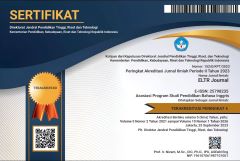COOPERATIVE LEARNING METHOD IN SENIOR HIGH SCHOOL ENGLISH CLASSES: STUDENTS’ AND TEACHERS’ PERCEPTIONS
Abstrak terlihat: 556 / PDF terunduh: 450DOI:
https://doi.org/10.37147/eltr.v7i2.172Keywords:
Cooperative Learning Method, Students' Perceptions, Teachers' PerceptionsAbstract
There are many methods in the English education world. One of them is a cooperative learning method. This paper aims to find the students’ and teachers’ perceptions of the cooperative learning method in Senior High School classes. This study used qualitative study. All data were analyzed qualitatively. The instruments used were questionnaires and semi-structured interviews. The participants were 45 students of one of the Senior High School English classes and 2 English teachers in Salatiga. Based on the findings, the cooperative learning method could potentially become an effective method for students. Based on the result, the students felt happy with this method. Moreover, this method could develop students’ teamwork skills. In teachers' perceptions, they taught through group work in this method could enhance students’ knowledge of the material. However, both students and teachers argued that this method could be less effective when there were uncooperative teammates in the group.
Downloads
References
Amedu, O. I., & Gudi, K. C. (2017). Attitude of students towards cooperative learning in some selected secondary schools in Nasarawa State. Journal of Education and Practice, 8(10), 29-34. https://eric.ed.gov/?id=EJ1139726
Arribas-Galarraga, N., & Zorrilla-Ramírez, B. (2020). Cooperative learning in higher education: The influence of individual learning styles. International Journal of Environmental Research and Public Health, 17(22), 1-18. https://doi.org/10.3390/ijerph17228487
Chang, S. C. (2011). A contrastive study of grammar translation method and communicative approach in teaching English grammar. ELT, 4(2), 13-24.
Dollman, L. (2007). Improving social skills through the use of cooperative learning. (Master's thesis). Saint Xavier University Chicago, Illinois. ERIC (ED496112). https://eric.ed.gov/?id=ED496112
Gillies, R. (2014). Cooperative learning: Developments in research. International Journal of Educational Psychology, 3(2), 125-140.
Hattie, J. (2015). The applicability of visible learning to higher education. Scholarship of Teaching and Learning in Psychology, 1(1), 79-91.
Jahanbakhsh, A. A., Zamani, M. A., & Garman, Z. (2019). CIRC and STAD in Iranian context: Through the five elements to cooperative learning of lexical collocations. Cogent Arts & Humanities, 6(1), 1692469. https://doi.org/10.1080/23311983.2019.1692469
Johnson, D. W., & Johnson, F. (2009). Joining together: Group theory and group skills (10th ed.). Boston, MA: Allyn & Bacon.
Johnson, D. W., & Johnson, R. T. (1999). Making cooperative learning work. Theory into Practice, 38(2), 67-73. https://doi.org/10.1080/00405849909543834
Johnson, D. W., & Johnson, R. T. (2001). Cooperative learning in English class of Chinese junior high school. Creative Education, 6(3), 371-379. https://doi.org/10.4236/ce.2015.63038
Johnson, D. W., Johnson, R. T., & Holubec, E. (1998). Cooperation in the classroom. Boston, MA: Allyn and Bacon.
Johnson, D. W., Johnson, R. T., & Smith, K. A. (2007). The state of cooperative learning in postsecondary and professional settings. Educational Psychology Review, 19(1), 15-29. https://doi.org/10.1007/s10648-006-9029-0
Johnson, D. W., Johnson, R. T., & Smith, K. A. (2014). Cooperative learning: Improving university instruction by basing practice on validated theory. Journal on Excellence in College Teaching, 25(3&4), 85-118.
Johnson, D. W., Johnson, R. T., & Stanne, M. B. (2000). Cooperative learning methods: A meta-analysis [Exhibit B]. Retrieved from http://www.tablelearning.com/uploads/File/EXHIBIT_B.pdf
Johnson, D. W., Johnson, R. T., & Stanne, M. B. (2014). Cooperative learning methods: A meta-analysis. Retrieved from https://www.researchgate.net/publication/220040324_Cooperative_learning_methods_A_meta-analysis
Kagan, S. (2013). Kagan cooperative learning structures. San Clemente, CA: Kagan Publishing.
Li, J., & Huang, L. (2017). The effect of cooperative learning on students’ happiness and life satisfaction. Journal of Happiness Studies, 18(5), 1425–1438. https://doi.org/10.1007/s10902-016-9777-0
Li, M. P., & Lam, B. H. (2005). Cooperative learning. The Hong Kong Institute of Education. Retrieved from http://www.ied.edu.hk/aclass/
Liu, Y., Cheng, J., & Hu, C. (2019). The limitations of cooperative learning in higher education and an alternative in individualized learning. International Journal of Higher Education, 8(1), 84-92. https://doi.org/10.5430/ijhe.v8n1p84
Macpherson, A. (2015). Cooperative learning group activities for college courses: a guide for instructors. from http://www.kwantlen.ca/academicgrowth/resources/CoopLearningActivities.do
Nasri, M., & Biria, R. (2017). Integrating multiple and focused strategies for improving reading comprehension and l2 lexical development of Iranian intermediate EFL learners. International Journal of Applied Linguistics & English Literature, 6(1), 311-321. http://dx.doi.org/10.7575/aiac.ijalel.v.6n.1p.311
Ning, H. (2011). Adapting cooperative learning in tertiary ELT. ELT Journal, 65(1), 60-70. https://doi.org/10.1093/elt/ccq021
Rerung, M. K. T. (2017). Reflecting translanguaging in classroom practices: A case study. Journal of English Language and Culture, 7(1), 17-22. http://dx.doi.org/10.30813/jelc.v7i1.1019
Ryan, R. M., & Deci, E. L. (2000). Intrinsic and extrinsic motivations: Classic definitions and new directions. Contemporary Educational Psychology, 25(1), 54-67. https://doi.org/10.1006/ceps.1999.20111020
Webb, N. M. (2008). Learning in small groups. In T. L. Good (Ed.), 21st century education: A reference handbook (pp. 203–211). Los Angeles: Sage.
Zhang, Y. (2010). Cooperative language learning and foreign language learning and teaching. Journal of Language Teaching and Research, 1(1), 81-83. https://doi.org/10.4304/jltr.1.1.81-83
Downloads
Published
How to Cite
Issue
Section
License
Copyright (c) 2023 Alfin Andya Ade Kriesna

This work is licensed under a Creative Commons Attribution-ShareAlike 4.0 International License.













